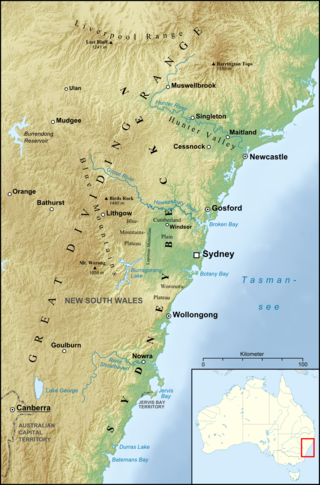
The Sydney Basin is an interim Australian bioregion and is both a structural entity and a depositional area, now preserved on the east coast of New South Wales, Australia and with some of its eastern side now subsided beneath the Tasman Sea. The basin is named for the city of Sydney, on which it is centred.

Koolasuchus is an extinct genus of brachyopoid temnospondyl in the family Chigutisauridae. Fossils have been found from Victoria, Australia and date back 125-120 million years ago to Barremian-Aptian stages of the Early Cretaceous. Koolasuchus is the youngest known temnospondyl. It is known from several fragments of the skull and other bones such as vertebrae, ribs, and pectoral elements. The type species Koolasuchus cleelandi was named in 1997. K. cleelandi was adopted as the fossil emblem for the state of Victoria, Australia on 13 January 2022.

The Wianamatta Group is a geological feature of the Sydney Basin, New South Wales, Australia that directly overlies the older Hawkesbury sandstone and generally comprise fine grained sedimentary rocks such as shales and laminites as well as less common sandstone units.

Bulgosuchus is an extinct genus of prehistoric amphibians, known from an incomplete mandible and a femur recovered from the Bulgo Sandstone at Long Reef in Sydney, Australia. The type species is Bulgosuchus gargantua, which was named in 1999.

The Narrabeen group of sedimentary rocks occurs in the Sydney Basin in eastern Australia. This series of rocks was formed in the Triassic Period.

Bringelly Shale is a component of the Wianamatta group of sedimentary rocks in the Sydney Basin of eastern Australia. Formed in the Triassic Period, it has an extensive outcrop in the western parts of Sydney. The shale has its greatest geographical extent at Bringelly, near the suburb of Liverpool.

Gregory John Retallack is an Australian paleontologist, geologist, and author who specializes in the study of fossil soils (paleopedology). His research has examined the fossil record of soils though major events in Earth history, extending back some 4.6 billion years. He has written two textbooks on paleopedology.

Bald Hill Claystone is a sedimentary rock found in the Sydney Basin in eastern Australia. It is part of the Clifton sub-group of the Narrabeen Group of sedimentary rocks. It was formed by weathering of the Gerringong Volcanics in the early Triassic. Named after Bald Hill, in the northern Illawarra, where it is 15 metres thick. The claystone is easily noticed at Long Reef, where it is 18 metres thick.

The Garie Formation is a narrow band of sedimentary rocks occurring in the Sydney Basin in eastern Australia. This stratum is up to 8 metres thick, situated below the sandstones of the Newport Formation. Formed in the mid-Triassic, it is part of the Narrabeen Group of sedimentary rocks. Garie formation consists of layers of clay pellet sandstone, dark lithic particles, spotted volcanic deposits and chocolate coloured claystone bands.

Long Reef is a prominent headland on the Northern Beaches of Sydney, Australia. Connected to the mainland by a tombolo, the reef has an extensive wave-cut platform. Long Reef is a popular recreational destination and is one of the more interesting geological areas in Sydney.
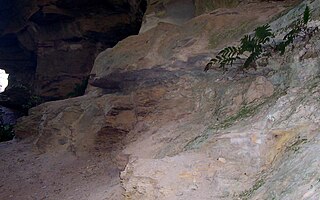
Mount York Claystone is a narrow band of sedimentary rocks occurring in the Sydney Basin in eastern Australia. This stratum is up to 13 metres thick. Mount York Claystone consists of red brown claystones, of fine‐grained and coarsely oolitic, kaolinite clayrocks.

Banks Wall Sandstone is a type of sedimentary rock occurring in the Sydney Basin in eastern Australia. This stratum is up to 115 metres thick. Often seen in the Blue Mountains, such as at the Three Sisters at Katoomba.

Burra-Moko Head Sandstone is a type of sedimentary rock occurring in the Sydney Basin in eastern Australia. This stratum is up to 112 metres thick. The rock is composed of quartzose to quartz lithic sandstone. It is situated below the Mount York Claystone in the Blue Mountains. Formed in the early Triassic, it is part of the Narrabeen Group of sedimentary rocks.
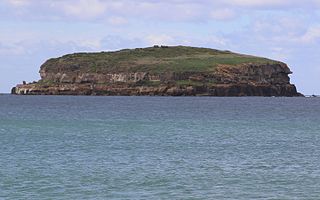
Munmorah Conglomerate is a geologic formation in the Sydney Basin in eastern Australia. This stratum is up to 140 metres thick. Formed in the early-Triassic, it is part of the Narrabeen Group of sedimentary rocks. This formation includes medium to coarse-grained sandstone and conglomerate. With minor amounts of siltstone and claystone. Below the Munmorah Conglomerates are Newcastle Coal Measures, originating from the Permian.

The Terrigal Formation is a geologic formation in the Sydney Basin in eastern Australia. Commonly seen in the Central Coast region, this stratum is up to 330 metres thick. Formed in the early to mid Triassic, it is part of the Narrabeen Group of sedimentary rocks. This formation includes interbedded fine to medium-grained sandstone and siltstone, with minor deposits of claystone. Hawkesbury Sandstone occasionally overlies the Terrigal Formation. Numerous fossils are known from this area, including the temnospondyl amphibians Arenaerpeton supinatus and Platycepsion wilksoni.
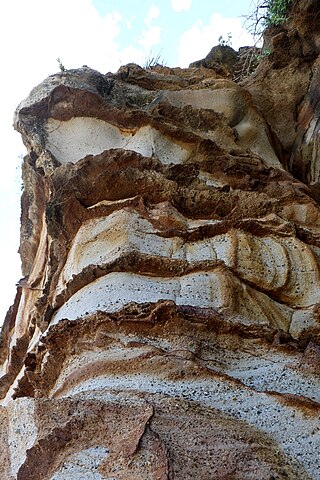
Scarborough Sandstone is a geologic formation in the Sydney Basin in eastern Australia. Commonly seen in the Illawarra region, this stratum is up to 26 metres thick. Formed in the early Triassic, it is part of the Narrabeen Group of sedimentary rocks. This formation includes quartz-lithic sandstone, sometimes with pebbles.

Stanwell Park Claystone is a geologic formation in the Sydney Basin in eastern Australia. Commonly seen in the Illawarra region, this stratum is up to 79 metres thick. Formed in the early Triassic, it is part of the Narrabeen Group of sedimentary rocks.This formation includes red, green and grey shale with quartz-lithic sandstone.
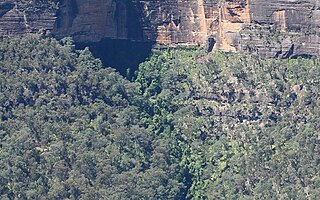
The Caley Formation is a band of sedimentary rocks occurring in the Sydney Basin in eastern Australia. This stratum is up to 46 metres thick. The formation consists of claystone, shale and quartz-lithic sandstone. Often seen situated below the Burra-Moko Head Sandstone in the cliffs of the Blue Mountains.
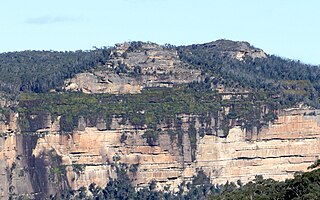
Wentworth Falls Claystone Member is a type of sedimentary rock occurring in the Sydney Basin in eastern Australia. This stratum may be seen above the Banks Wall Sandstone in the Blue Mountains, west of Sydney. Part of the Narrabeen Group of Sedimentary Rocks, formed in the Triassic. Wentworth Falls Claystone Member is composed of thick claystone and siltstone red beds.
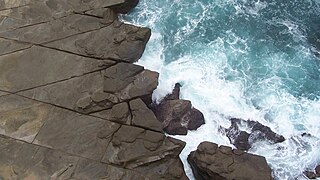
Wombarra Claystone is a geologic formation in the Sydney Basin in eastern Australia. Commonly seen in the Illawarra region, this stratum is up to 30 metres thick. Formed in the late Permian to the early Triassic, it is part of the Narrabeen Group of sedimentary rocks. This formation includes grey shale, and minor quartz-lithic sandstone.




















